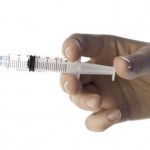No prep necessary in new, easy-to-use hexavalent DTP, polio, hep B and Hib vax for kids.
The National Immunisation Program schedule now includes a new hexavalent vaccine for diphtheria, polio, hepatitis B and Hib in a ready-for-use syringe, that was designed to avoid preparation errors and cut time for busy GPs and other providers.
The new delivery method offers a one-step, one-injection option for vaccination of infants from as young as six weeks against diphtheria, tetanus, pertussis, hepatitis B, poliomyelitis and invasive diseases caused by Haemophilus influenzae type b.
“With around 300,000 babies born every year in Australia and an immunisation coverage rate of around 94%, our aim has been to give healthcare professionals an effective vaccine that is easy to prepare and administer,” said Dr Iris Depaz, representative for Sanofi Australia and New Zealand.
Vaxelis, developed by Sanofi and MSD, is an alternative to the currently listed Infanrix hexa (GSK) – a combined vaccine for the six diseases that requires the extra step of reconstituting a pre-filled syringe and a freeze-dried pellet.
Schedule for vaccination remains the same as current practice – 0.5mL doses in the thigh or arm at two, four and six months.
According to the product information, primary vaccination schedule is of two or three doses, with an interval of at least one month between doses.
“Where a dose of hepatitis B vaccine is given at birth, Vaxelis can be used for supplementary doses of hepatitis B vaccine from the age of six weeks,” it said.
“If a second dose of hepatitis B vaccine is required before this age, monovalent hepatitis B vaccine should be used. Vaxelis can be used for a mixed hexavalent/pentavalent/hexavalent combined vaccine immunisation schedule.”
Children under 10 who haven’t had the course need catch-up doses as outlined in the Australian Immunisation Handbook.
Vaccine providers should be consistent in the brand of vaccination used during the course of immunisation, according to health authorities.
Children with uncontrolled neurological disorders, epilepsy or history of allergic reaction or encephalopathy to components of the vaccine, especially for whooping cough vaccines, should not be vaccinated.
Caution should be taken when administering the vaccine in premature babies and immune-compromised children.
Providers also need to carefully weigh the potential benefits and possible risks of vaccinating infants who have had Guillain-Barré syndrome within six weeks of receiving a tetanus shot, according to the product information. History of febrile convulsion, SIDS, thrombocytopenia or bleeding disorder may also cause complication.
The vaccine can be co-administered with pneumococcal polysaccharide conjugate vaccines, rotavirus vaccines, MMR and varicella containing vaccines, meningococcal C conjugate vaccines and meningococcal serogroup C vaccines.
The vaccine can also be co-administered with pneumococcal conjugate vaccine (PCV13).
Side effects can include irritability, crying, drowsiness, injection site reactions, fever, decreased appetite and vomiting.
But serious reactions to the combined vaccines are rare.
Correction: This story originally said Vaxelis should not be co-administered with PCV13 – an overstatement of a product warning about slightly higher rates of fever when used as a booster in the second year of life, according to one study.




